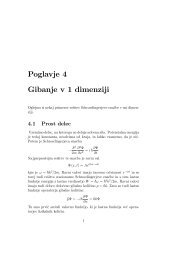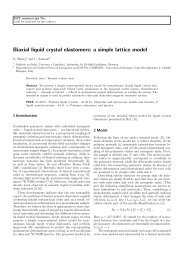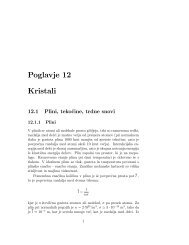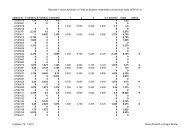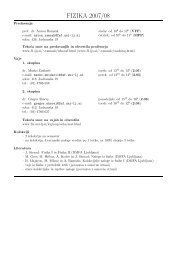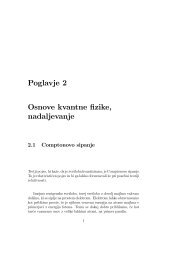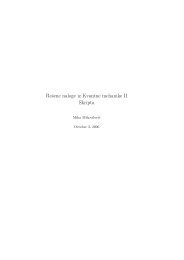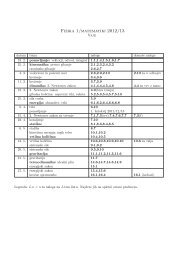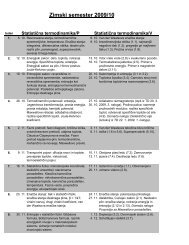INHOMOGENEOUS TRANSLATIONAL DIFFUSION IN POLYMER ...
INHOMOGENEOUS TRANSLATIONAL DIFFUSION IN POLYMER ...
INHOMOGENEOUS TRANSLATIONAL DIFFUSION IN POLYMER ...
Create successful ePaper yourself
Turn your PDF publications into a flip-book with our unique Google optimized e-Paper software.
<strong><strong>IN</strong>HOMOGENEOUS</strong> <strong>TRANSLATIONAL</strong> <strong>DIFFUSION</strong> <strong>IN</strong> <strong>POLYMER</strong>-DISPERSED LIQUID CRYSTALS: MONTE CARLO SIMULATIONSOF NMR SPECTRACESARE CHICCOLI, a PAOLO PAS<strong>IN</strong>I, a GREGOR SKACEJ, bCLAUDIO ZANNONI, cand SLOBODAN ZUMER baIstituto Nazionale di Fisica Nucleare, Sezione di Bologna, Via Irnerio 46,I-40126 Bologna, ItalybPhysics Department, University of Ljubljana,Jadranska 19, SI-1000 Ljubljana, SloveniacDipartimento di ChimicaFisica ed Inorganica, Universita di Bologna, Viale Risorgimento 4, I-40136Bologna, ItalyThe methodology for calculating 2 H NMR spectra, starting from MonteCarlo simulations of nematic droplets, is briey reviewed. We focus oneects of translational diusion, in particular on inhomogeneities in molecularmotion close to the droplet wall, and establish a correspondence withthe resulting NMR spectra for radial and bipolar droplets. Finally, wealso present spectra for samples containing several bipolar droplets withrandomly oriented droplet symmetry axes.Keywords: polymer-dispersed liquid crystals deuterium NMR MonteCarlo simulations translational diusion<strong>IN</strong>TRODUCTIONPolymer-dispersed liquid crystals (PDLC) have over the past decade becomeimportant both for technological applications and for studies of liquidcrystalline ordering in a strongly conned environment. [1]Dependingon the polymer matrix and on preparation methods, dierent structures
C. CHICCOLI et al.can be observed inside nematic droplets. The radial for homeotropic surfaceanchoring [23] and the bipolar for planar anchoring [234] (Fig. 1) arethe most known. Experimentally, various techniques have been appliedto study these complex systems, for example calorimetry, light scattering,polarized light microscopy, and deuterium ( 2 H) NMR. [1;4]On theother hand, theoretical approaches based on elastic continuum theory [1]and computer simulations | predominantly of Monte Carlo (MC) type [5]| have been widely used to study PDLC and to express the results inform of experimental observables like polarized light textures or 2 H NMRspectra. [6;8]FIGURE 1 Molecular ordering inside a PDLC droplet at a nematictemperature (depicted schematically) (a) radial, (b) bipolar structure.Recently, wehave developed a methodology for employing the numericaloutput from MC simulations to calculate 2 H NMR spectra, which hasbeen demonstrated to be appropriate also in presence of signicant molecularmotion, including uctuations of molecular long axes and moleculartranslational diusion. [910]However, in a thin layer close to the polymersubstrate the diusive motion is slowed down signicantly, as seen in someexperimental studies. [1112]The present paper deals with the simulationsof this eect in bipolar and radial droplets, applying the methodologypresented in Refs. [910] and described briey in the next Section. Theresulting spectra are then presented and interpreted qualitatively in thelast two Sections.MONTE CARLO SIMULATIONS AND CALCULATION OF NMRSPECTRATo simulate the nematic liquid crystal we use a model system suggestedby Lebwohl and Lasher decades ago: [13]nematic molecules or close-packedmolecular clusters containing up to 100 molecules are represented by particles(\spins") which are arranged into a simple cubic lattice, but canrotate freely. Denoting the orientation of the jth particle by aunitvector
<strong><strong>IN</strong>HOMOGENEOUS</strong> <strong>TRANSLATIONAL</strong> <strong>DIFFUSION</strong>...u j and the interaction strength constant by , in absence of external eldsthe total interaction energy of N particles can be written asU N = ; X h i3(u i u j ) 2 ; 1 (1)2hi
C. CHICCOLI et al.To include dynamic eects when spectra are calculated, it is convenientto apply a semiclassical approach with the time-dependent deuteronspin Hamiltonian. [17]This approach consists of generating the relaxationfunctionD Z t EG(t) = exp(i! Z t) exp [i j Q (t0 ) dt 0 ] (3)j0 3(uj B 0 =B 0 ) 2 ; 1 =2, u j = u j (t) standing for thewith j (t) = Q ! Q\instantaneous" orientation of the jth particle, and h:::i j denoting an ensembleaverage over all particles in the sample. Once the G(t) function isgenerated, the NMR R spectrum I(!) is calculated by performing a Fouriertransform I(!) = exp(i!t) G(t) dt. In our simulation the orientationsu j are obtained from the 1024 MC congurations, which reproduces theeect of uctuating molecular long axes. Translational diusion, however,is simulated by anisotropic random walk process on the lattice. Withinthis process, in every diusion step each particle \jumps" to a randomlychosen neighbor lattice site, thereby acquiring the instantaneous orientationu j at the new position.As suggested by experimental results, in a thin subsurface layer moleculardiusive motion is hindered, which results in a signicant reductionof the eective diusion constant D (even by a factor of 3 10 3 ) [1112] . Inthe simulation, the thickness of this layer was set to roughly one particledimension (up to 5 nm), thereby leaving 1608 particles (out of 5832) inthe subsurface region. Then the rate of diusive moves within this regionwas reduced and the same reduction factor was assumed also for movesentering or leaving the surface layer. Note also that since nematics areanisotropic liquids, the process of translational diusion is anisotropic.Consequently, the ratio of the diusion constants measured along andperpendicular to the director n can typically be of the order of 2. [218]However, since we are primarily interested in qualitative features of spectra,for simplicity thediusive process is assumed to be isotropic. Somepreliminary tests with anisotropic diusion show that qualitatively ourresults do not change.Quantitatively, the degree of diusional averaging can be determinedby calculating the value of the dimensionless parameter e = ! Q R 2 =12D. [2]For e 1 the average molecular displacement p 6Dt 0 within the characteristicNMR time scale t 0 ! ;1is much smaller than the characteristicQsystem size (droplet radius R). Consequently, ! Q (r) does not changesignicantly on the t 0 time scale, which corresponds to the \static" (nodiusion)limit. On the other hand, e 1 with p 6Dt 0 R correspondsto the fast diusion limit where NMR spectra are motionally av-
<strong><strong>IN</strong>HOMOGENEOUS</strong> <strong>TRANSLATIONAL</strong> <strong>DIFFUSION</strong>...eraged. Consequently, for given D and ! Q diusive eects are importantin smaller droplets, where the director n and ! Q vary signicantly overshorter distances. In cases we claim to correspond to the fast diusionlimit in the simulation, we have e 0:56. Despite the condition e 1is still far from being fullled, eects of diusion are already signicant,while a further increase of the diusion rate would only decrease the linewidths. For ! Q 2 40 kHz and D 4 10 ;11m 2 =s, e 0:56 canbe expressed in terms of the droplet radius, indicating that spectra ofdroplets with radii below 60 nm are already diusion-averaged. With asingle particle in the simulation representing up to 100 nematic molecules,the maximum droplet radius that we can simulate also approaches60nm.Therefore, we are always in the fast diusion regime and the no-diusionspectra will only be given for a better comprehension. Further, since thedroplet is rather small and a signicant portion ( 28%) of particles liesin the surface layer, a substrate-induced slowdown in translational diusionis expected to be clearly visible. For any further details the reader isreferred to our previous papers. [910]SPECTRA: RADIAL AND BIPOLAR DROPLETFirst consider the droplet with radial boundary conditions at T = k B T== 0:8, which assures the existence of the nematic phase. In the radialcase with homeotropic surface anchoring all particles are directed radiallyfrom the droplet center, while in the center there is a rather small defectcore (Fig. 1). [19]Ignoring translational diusion, the spectrum consistsof two asymmetric peaks and is similar to the Pake-type powder pattern[Fig. 2 (a)], characteristic for any orientationally isotropic moleculardistribution. [17]Note that the total width of the spectrum is less than2 ! Q , which is a consequence of uctuating molecular long axes. Fromthe positions of the two peaks known to be situated at 1 ! 2QS, one canestimate the value of the scalar order parameter S and compare it withthe results obtained directly from MC data. [910]To smoothen the rathernoisy spectra, we have performed a convolution with a Gaussian kernelwhose width was rather large (0:04 ! Q ).Allowing now particles to diuse rapidly throughout the whole droplet,the double-peaked pattern collapses into a single peak centered at zeroquadrupolar splitting, as shown in Fig. 2(c). Generally, in the fast diffusionlimit the spectrum is expected to consist of two well-dened symmetriclines located at h! Q i, where h:::i denotes an average over the dif-
C. CHICCOLI et al.fusive motionr(t) ofagiven particle within the characteristic NMR timescale. [217]Since for any isotropic orientational particle distribution wehave h! Q i = 0, in the spectrum there is a single peak at zero splitting.FIGURE 2 Spectra of the radial droplet at T =0:8: no diusion (a),fast diusion: inhomogeneous (b) and homogeneous (c). Everywherespectra are normalized so as to yield the same peak height.If surface inhomogeneities in translational diusion are taken into account,in the spectra | apart from the diusion-averaged central peak| there are now two well-pronounced peaks at 0:36 ! Q , plus some additionalsignal at frequencies 0:4 ! Q < j! Q j < 0:8 ! Q . The spectrumdisplayed in Fig. 2(b) was calculated for D b =D s = 3 10 3 , where D band D s are the eective diusion constants in the bulk and in the surfacelayer. [11] Since the ratio D b =D s is rather large, in the surface layer containing28% of molecules there is almost no diusive motion in comparison tothe droplet core. Therefore, it is possible to understand the spectrum depictedin Fig. 2 (b) as a weighted superimposition of a diusion-averagedcontribution originating from the droplet core | the central peak | andof an underlying Pake-type pattern originating from the surface layer, affectedonly negligibly by the slow diusion. Then from peak positions0:36 ! Q one can roughly estimate the value of the order parameter in
<strong><strong>IN</strong>HOMOGENEOUS</strong> <strong>TRANSLATIONAL</strong> <strong>DIFFUSION</strong>...the surface layer, which yields S 0:72. For that layer the S-proles calculatedfrom MC data give S 0:80 [10]and the agreement is sucientlygood.FIGURE 3 Spectra of the bipolar droplet at T =0:8: no diusion (a),fast diusion: inhomogeneous (b) and homogeneous (c).In the bipolar case, surface anchoring is planar and in the droplet coremost particles are aligned along a given direction, determined by the bipolarsymmetry axis (Fig. 1). Where the axis intersects the droplet surface,there are two defects at the \poles" of the droplet. In our case the bipolaraxis was chosen parallel to the spectrometer magnetic eld. Consequently,in the no-diusion regime the spectrum consists of two lines positionedapproximately at ! Q S [see Fig. 3 (a)]. Again, one can deduce the valueof S from the peak positions. Considering the homogeneous fast diusioncase, the two lines in the spectrum move towardsalower splitting jh! Q ij[Fig. 3 (c)]. This is expected since not all particles are exactly parallel tothe spectrometer eld and thus yield smaller j! Q j contributions when theaverage h:::i is performed. If, however, diusion is inhomogeneous [againwith D b =D s =3 10 3 Fig. 3 (b)], the two main peaks in the spectrummove slightly apart, but do not exceed the initial splitting obtained in the
C. CHICCOLI et al.diusionless case. The diusive paths of particles now mostly avoid thesurface region where the curvature of the director eld is strongest and,consequently, the deviations from the maximum j! Q j are largest, whichexplains the re-positioning of the main peaks. Further, there are twoadditional \shoulders" positioned at a splitting slightly larger than thatcorresponding to the main peaks. These \shoulders" originate from thediusion-unaected surface layer, especially from particles aligned almostalong the spectrometer eld. Note that the \shoulder" positions matchwith the positions of the two main peaks obtained in absence of diusionquite well.\POWDER" SAMPLE: BIPOLAR DROPLETSIn most experimental NMR studies of PDLC [2414;16]bipolar dropletshave been observed. In a real sample there are many droplets whosesymmetry axes are oriented randomly. Macroscopically, such sample isisotropic although the constituent bipolar droplets are not. Then, sincethe NMR spectrum is a collective response of all droplets inside the sample,in the spectrum one should expect to see the Pake-type pattern |characteristic for isotropic orientational distributions | instead of thetwo-peaked spectrum obtained for a single droplet (see previous Section).In an experiment, the two-peaked spectrum can be obtained only if allbipolar symmetry axes are preliminarily aligned by a strong external electricor magnetic eld.Although we only have the MC data for one droplet available, it ispossible to simulate the eect of randomly oriented droplet symmetryaxes by using the unaltered single droplet data and by assuming to havea random distribution of spectrometer magnetic eld directions. Since wesimply \clone" the data for a single droplet to model several droplets, thiscertainly results in unphysical correlations between particle orientationsin dierent droplets, but at least in cases with diusion this should notbe of great importance since interdroplet correlations are smeared out byindependent diusion paths in each droplet. Note that now spectra showmuch less noise than for a single droplet and it is not necessary to performsmoothening convolutions.Fig. 4 (a) shows the spectrum of 1000 bipolar droplets without diusionat T =0:8 (nematic phase). It presents a Pake-type pattern, as expected,with peaks positioned at 0:37 ! Q . This suggests that S 0:74,which is close to S 0:73, a value deduced from peak positions for a single
<strong><strong>IN</strong>HOMOGENEOUS</strong> <strong>TRANSLATIONAL</strong> <strong>DIFFUSION</strong>...bipolar droplet | see Fig. 3 (a). In the spectrum, fast and homogeneousdiusion again results in a Pake-type pattern, albeit somewhat narrowed[Fig. 4 (c)]. The ratio of line widths measured peak-to-peak in cases withand without fast diusion should be equal to that calculated for a singlebipolar droplet. For a single droplet this ratio is estimated by 0.83, whilefor an array of 1000 droplets we have 0.80, indicating that the agreementis good.FIGURE 4 Spectra of 1000 bipolar droplets at T = 0:8, with symmetryaxes oriented randomly: no diusion (a), fast diusion: inhomogeneous(b) and homogeneous (c).Finally, if diusion is inhomogeneous [Fig. 4 (b)], the spectrum is stillsimilar to the Pake-type pattern, however, with less width reduction thanin the homogeneous diusion case. In addition, at splittings slightlylarger than those corresponding to the main peaks, two \shoulders" appearagain. Note that all these features agree with those observed fora single bipolar droplet compare with Fig. 3(b). The spectrum shownin Fig. 4(b) actually consists of two superimposed Pake-type patterns.The rst one | comprising the two main peaks | is well pronouncedand originates from central droplet regions where diusion is eective.
C. CHICCOLI et al.The two \shoulders", on the other hand, are the main peaks of the lesspronounced, but not diusion-narrowed second Pake-type pattern representingthe response from droplet surface layers. Note that the \shoulder"and no-diusion peak positions [Fig. 4 (a)] match again.CONCLUSIONSIn this paper, we presented calculations of NMR spectra for bipolar andradial nematic droplets, starting from the numerical output of MonteCarlo simulations. Calculating the spectra, we focused on dynamic eects,especially on translational diusion and on its slowing-down in the surfacelayer. If close to the conning substrate diusion is signicantly slowerthan in the bulk liquid crystal, this results in perceptible changes in NMRspectra. These changes should be detectable also experimentally in smallenough droplets. Finally, we calculated some \powder" spectra for anarray of many bipolar droplets with randomly oriented symmetry axes andfound a good qualitative agreement with the expected Pake-type patterns.AcknowledgmentsC. Z. wishes to thank the University of Bologna, CNR and MURST (PR<strong>IN</strong>\Cristalli Liquidi") for support. C. C. and P. P. are grateful to <strong>IN</strong>FNthrough the grant IS BO12. G. S. and S. Z. acknowledge the nancialsupport of the Ministry of Science and Technology of Slovenia (Grant No.J1-7470) and of the European Union (Project SILC TMR ERBFMRX-CT98-0209).References1. G. P. Crawford and S. Zumer, Liquid Crystals in Complex GeometriesFormed by Polymer and Porous Networks (Taylor and Francis,London 1996).2. A. Golemme, S. Zumer, J. W. Doane, and M. E. Neubert, Phys. Rev.A 37, 559 (1988).3. R. Ondris-Crawford, E. P. Boyko, B. G. Wagner, J. H. Erdmann,S. Zumer, and J. W. Doane, J. Appl. Phys. 69, 6380 (1991).4. R. Aloe, G. Chidichimo, and A. Golemme, Mol. Cryst. Liq. Cryst.203, 1155 (1991).
<strong><strong>IN</strong>HOMOGENEOUS</strong> <strong>TRANSLATIONAL</strong> <strong>DIFFUSION</strong>...5. P. Pasini and C. Zannoni, Advances in the Computer Simulationsof Liquid Crystals (Kluwer, Dordrecht 2000).6. C. Chiccoli, P. Pasini, F. Semeria, E. Berggren, and C. Zannoni,Mol. Cryst. Liq. Cryst. 266, 241 (1995).7. E. Berggren, C. Zannoni, C. Chiccoli, P. Pasini, and F. Semeria,Phys. Rev. E 49, 614 (1994).8. E. Berggren, C. Zannoni, C. Chiccoli, P. Pasini, and F. Semeria,Phys. Rev. E 50, 2929 (1994).9. C. Chiccoli, P. Pasini, G. Skacej, C. Zannoni, and S. Zumer, Phys.Rev. E 60, 4219 (1999).10. C. Chiccoli, P. Pasini, G. Skacej, C. Zannoni, and S. Zumer, toappear in Phys. Rev. E 62 (2000).11. G. P. Crawford, D. K. Yang, S. Zumer, D. Finotello, and J. W.Doane, Phys. Rev. Lett. 66, 723 (1991).12. M. Vilfan, G. Lahajnar, I. Zupancic, S. Zumer, R. Blinc, G. P.Crawford, and J. W. Doane, J. Chem. Phys. 103, 8726 (1995).13. P. A.Lebwohl and G. Lasher, Phys. Rev. A 6, 426 (1972).14. M. Ambrozic, P.Formoso, A. Golemme, and S. Zumer, Phys. Rev. E56, 1825 (1997).15. A. Golemme, S. Zumer, D. W. Allender, and J. W. Doane, Phys. Rev.Lett. 61, 2937 (1988).16. J. Dolinsek, O. Jarh, M. Vilfan, S. Zumer, R. Blinc, J. W. Doane,and G. Crawford, J. Chem. Phys. 95, 2154(1991).17. A. Abragam, The Principles of Nuclear Magnetism (Clarendon Press,Oxford 1961).18. P. G. de Gennes and J. Prost, The Physics of Liquid Crystals (ClarendonPress, Oxford 1993).19. C. Chiccoli, P. Pasini, F. Semeria, T. J. Sluckin, and C. Zannoni,J. Phys. II 5, 427 (1995).





